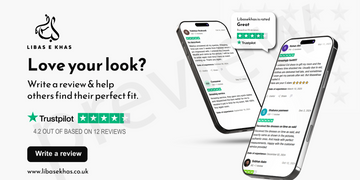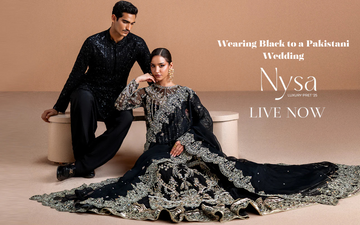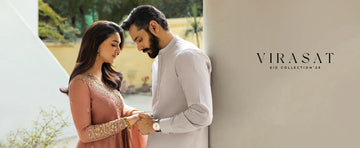What’s the difference between Saree and Lehenga? Choosing the ideal Pakistani ethnic outfit for a special occasion can feel both exciting and overwhelming. For many, especially those navigating weddings, festivals, or milestone celebrations, the question arises: Saree or Lehenga? This choice goes beyond fashion. It touches on comfort, personal style, cultural meaning, and the way you want to present yourself at an important event.
If you have ever felt unsure about which garment fits the occasion, struggled with draping or styling, or wondered how to balance tradition with modern trends, you are not alone. These dilemmas are common, yet they can make the process stressful.
What is a Saree?
The saree, an unstitched length of fabric, is one of the most iconic symbols of Indian femininity and tradition. Its charm lies in its versatility, allowing wearers to drape it in numerous ways that reflect regional heritage, personal style, and the occasion itself.
Definition and Structure
A saree is a single, continuous piece of fabric, usually between 5 and 9 yards (4.5 to 8 meters) long and around 45 inches (1.1 meters) wide. Despite its simplicity, the saree forms a complete outfit when paired with essential components:
Saree Fabric: The main draped cloth that defines the silhouette and overall look.
Blouse (Choli): A fitted top, often short-sleeved, worn beneath the saree.
Petticoat (Underskirt): A simple skirt worn under the saree to hold pleats in place and provide structure.


Cultural Significance
The saree is a symbol of grace, tradition, and cultural heritage across India. Worn for centuries, it has evolved in patterns, fabrics, and embellishments while retaining its timeless form. Each regional drape tells a story, connecting the wearer to centuries of artistry and social customs.
Draping Versatility
One of the saree’s most remarkable features is its draping flexibility. Popular styles include Nivi, Bengali, Gujarati, and Maharashtrian drapes, among hundreds of others. Correct draping transforms the saree, enhancing posture, elegance, and comfort. For cultural and aesthetic accuracy, it is important to respect traditional draping methods.
Key Characteristics
-
Requires practice and skill to drape elegantly.
-
Offers a flowing, graceful silhouette suitable for various occasions.
-
Adaptable for both formal and casual events depending on fabric, color, and embellishments.
The pleats and pallu are central to the saree’s overall impact. If you are new to draping, consider practicing in advance or opting for a pre-draped saree to achieve effortless elegance.
What is a Lehenga?
The lehenga, a three-piece ensemble, is celebrated for its regal and festive appearance. It is a preferred choice for weddings, receptions, and other grand celebrations, offering a combination of tradition, style, and comfort.
Definition and Structure
A lehenga consists of a traditional skirt paired with a fitted blouse and a complementing dupatta. The skirt is often embellished with embroidery, sequins, or other decorative elements, making it a statement piece for special occasions.
Components
Lehenga (Skirt): A long, flared skirt secured at the waist. It comes in various cuts, including A-line, circular, mermaid, and heavily flared silhouettes.
Choli (Blouse): A fitted top, either short or long-sleeved, designed to match or complement the skirt.
Dupatta (Scarf/Veil): A long scarf draped over the head, shoulder, or around the body to complete the ensemble.

Cultural Significance
Lehengas are most closely associated with bridal wear and festive occasions, symbolizing celebration, elegance, and opulence. Modern interpretations have expanded its appeal, making it suitable for contemporary parties and formal events while retaining traditional charm.
Wearability
Compared to a saree, a lehenga is generally easier to wear. Being a pre-stitched garment, it offers structure and simplifies styling for those who may be new to Indian ethnic wear. Visuals and descriptions should accurately reflect the garment’s structure and cultural context for authenticity.
Key Characteristics
-
Creates a structured and voluminous silhouette that stands out in photographs and gatherings.
-
Provides comfort and freedom of movement, particularly suitable for dancing and socializing.
Offers styling flexibility through mix-and-match combinations of cholis and dupattas.
A lehenga’s silhouette and embellishments can transform your overall presence. Choose the cut and fabric that suit your body type and the occasion to achieve both elegance and comfort.
Key Differences: Saree vs. Lehenga
Choosing between a saree and a lehenga becomes much easier when you understand their core differences. Each garment offers a distinct silhouette, wearability, and cultural expression. The table below highlights the fundamental distinctions to guide your decision:
|
Attribute |
Saree Characteristics |
Lehenga Characteristics |
|
Construction |
Single unstitched length of fabric, typically 5–9 yards |
Three separate pieces: skirt, blouse, and dupatta |
|
Draping/Wearability |
Requires intricate draping; beginners may need practice to achieve an elegant look |
Relatively easier to wear; pre-stitched or structured like a skirt and top for convenience |
|
Silhouette |
Flowing and draped, often accentuating natural curves; draping style alters overall look |
Fitted at the waist with a flared skirt; structured silhouette creates a voluminous, regal appearance |
|
Comfort |
Can feel restrictive if pleats or pallu are not managed properly |
Offers more freedom of movement and comfort, ideal for dancing or extended wear |
|
Versatility |
Highly versatile in draping; can be styled traditionally or with contemporary twists |
Design versatility through different cuts, fabrics, and embellishments, but fundamental form remains consistent; cholis and dupattas can be mixed and matched |
|
Maintenance |
Requires careful handling and storage to preserve fabric and drape |
Structured pieces are easier to manage, though heavy embroidery may need professional cleaning |
|
Weight |
Varies depending on fabric and embellishments; can range from light to heavy |
Often heavier due to layered skirts and intricate embroidery |
|
Occasion Appropriateness |
Ideal for formal, traditional, and cultural events; can be adapted for semi-formal occasions with contemporary styling |
Best suited for weddings, grand celebrations, and festive events where a statement look is desired |
Your choice should consider both the occasion and your comfort level. Sarees offer timeless elegance and adaptability, while lehengas provide a structured, dramatic presence with easier wearability.
When to Wear a Saree: Occasions and Considerations
The saree’s timeless elegance makes it a versatile choice for a wide range of occasions. Its flowing silhouette, cultural significance, and adaptability ensure that it remains a preferred option for both traditional and contemporary events.
Formal Ceremonies and Receptions
Traditional Weddings: Sarees are ideal for the bride’s mother, close relatives, or guests attending the main ceremony. Opt for rich silks or intricately embroidered fabrics to reflect the occasion’s importance.
Formal Receptions: A classic silk or designer saree exudes sophistication, making it perfect for high-profile or formal gatherings.
Choose a classic saree for traditional ceremonies or receptions. The elegance of a well-draped saree conveys refinement while honoring cultural traditions.
Professional and Semi-Formal Settings
Cultural Events and Galas: Sarees represent Indian heritage gracefully, making them a suitable choice for formal cultural events or award functions.
Workplace Formalities: In professional settings in India, simple cotton or silk sarees provide a polished, respectful appearance without compromising comfort.
Traditional Festivals
Sarees shine during festive celebrations such as Diwali, Durga Puja, and other regional festivals. Vibrant colors, traditional prints, or handcrafted embroidery enhance the festive spirit while honoring tradition.
Practical Consideration: When selecting a saree for any occasion, consider the fabric, draping style, and level of embellishment. These factors influence comfort, ease of movement, and the overall impression you make.
Pros and Cons of Each Garment
Weighing the advantages and limitations of a saree and a lehenga can help you make a confident choice, balancing comfort, style, and occasion suitability.
Saree
Pros
-
Timeless Elegance: Offers unmatched grace and sophistication that works across generations.
-
Versatility in Draping: Multiple draping styles allow you to create unique looks from a single garment.
-
Cultural Significance: Deeply rooted in tradition, making it ideal for formal and ceremonial occasions.
-
Body Flattering: Can be draped to enhance and complement various body types.
-
Investment Piece: High-quality silk or designer sarees can become family heirlooms.
Cons
-
Draping Difficulty: Requires practice and can be time-consuming for beginners.
-
Movement Restriction: Tightly draped sarees may limit movement or dancing.
-
Maintenance: Delicate fabrics and intricate drapes need careful handling.
-
Pre-event Preparation: Often requires a specific blouse and petticoat for the perfect look.
Lehenga
Pros
-
Ease of Wear: Simple to wear, similar to a skirt and top, making it beginner-friendly.
-
Comfort and Movement: Provides greater freedom for dancing and long events.
-
Grand and Festive Look: Naturally creates a celebratory, opulent appearance.
-
Mix-and-Match Potential: Cholis and dupattas can be paired with other outfits for varied looks.
-
Modern Adaptations: Easily styled for contemporary or fusion events while retaining traditional appeal.
Cons
-
Less Draping Versatility: Primarily one silhouette, though different skirt cuts provide some variation.
-
Cost: Heavily embellished or designer lehengas can be expensive.
-
Weight: Detailed embroidery and layered skirts may feel heavy during long wear.
-
Re-wearability: Grand styles may feel too formal for multiple events, although creative styling can extend their use.
Consider the garment’s versatility and potential for re-wear. Pieces that can be restyled for multiple occasions provide better long-term value without compromising elegance.
Conclusion: Making Your Informed Choice
Ultimately, choosing between a saree and a lehenga is a personal decision shaped by the occasion, your comfort, and your individual style. Both garments are exquisite representations of Indian culture and fashion, each offering its own charm and appeal.
Key Takeaways
-
Saree: Embodies grace, tradition, and timeless elegance. Ideal for formal ceremonies, traditional events, and anyone who appreciates the artistry of intricate draping.
-
Lehenga: Reflects grandeur, comfort, and contemporary flair. Perfect for weddings, festive celebrations, or those who prioritize ease of wear and freedom of movement.





